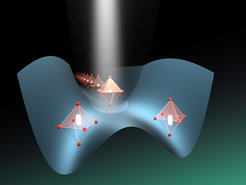Short X-ray pulses reveal the source of light-induced ferroelectricity in SrTiO3
Mid-infrared and terahertz frequency laser pulses are powerful tools to manipulate the properties of quantum materials through tailored modifications of their crystal structure. Light-induced ferroelectricity in SrTiO3 is a remarkable demonstration of these physics. Under mid-infrared illumination, this material transforms into a state of permanently ordered electrical dipoles, which is absent in its equilibrium phase diagram. The mechanism underlying this transformation is not understood. Now, a team of researchers of the Max Planck Institute for the Structure and Dynamics of Matter (MPSD) in Germany and the SLAC National Accelerator Laboratory in the United States has performed an experiment at the SwissFEL X-ray Free-Electron Laser to identify the intrinsic interactions relevant to creating this state. The new insight was gained not by detecting the position of the atoms, but by measuring the fluctuations of these atomic positions. The result provides evidence that these fluctuations are reduced, which may explain why the dipolar structure is more ordered than in equilibrium, and why a ferroelectric state could be induced. The work by the Cavalleri group has appeared in Nature Materials.

Ferroelectric materials are characterized by the spontaneous parallel alignment of electric dipoles, leading to a macroscopic polarization that can point in two opposite directions. The pointing direction can be switched by an electric field, enabling the use of ferroelectrics in the digital storage and processing components of modern electronic devices.
Strontium titanate, SrTiO3, is a so-called quantum paraelectric. Unlike many of the ferroelectric materials, SrTiO3 lacks a macroscopic ferroelectric state. Yet, abundant experimental evidence shows that quantum fluctuations of the crystal lattice prevent the long-range order from developing. Surprisingly, in 2019 the Cavalleri group found that SrTiO3 transforms into a ferroelectric when certain vibrations of the crystal lattice are excited by intense pulses in the mid-infrared. The use of light to induce and control ferroelectricity at electronically inaccessible high frequencies can be envisioned as the key element of future high-speed memory applications.
At the time, the nonlinear response of the crystal lattice was speculated to be the origin of this effect, resulting in the formation of strain that helps the material to become ferroelectric. However, direct measurements of the strain and, even more importantly, of the fluctuations of the atomic positions on the earliest timescales after the mid-IR excitation were lacking.
The researchers teamed up with Mariano Trigo’s group at SLAC and combined the mid-infrared excitation with femtosecond X-ray pulses from the SwissFEL free electron laser to shine light on these dynamics, which take place on the sub-picosecond time scale – shorter than a trillionth of a second. “In a typical X-ray diffraction experiment, one makes use of the constructive interference of the X-rays scattered from the periodically aligned atoms to measure their average positions,” says Michael Först, one of the leading authors of this work. “But here, we detected the diffuse scattering arising from disorder in the atomic arrangement which is sensitive to fluctuations, in other words noise, of the crystal lattice”.
Experimentally, the team found that the fluctuations of certain rotational modes in the SrTiO3 lattice, which obstruct the formation of long-range ferroelectricity, were rapidly reduced by the pulsed mid-infrared excitation. Such suppression does not occur in this material in equilibrium and hints at the origin of the light-induced ferroelectricity. This was confirmed by a rigorous theoretical analysis that revealed complex, high-order interactions between a set of lattice vibrations and the strain as the source of these observations. Michael Fechner, the theorist of this project, emphasizes the importance of the collaboration between theory and experiment: "It allows us to sharpen our tools for predictions and, consequently, to enhance our understanding of matter and its interactions with light."
Andrea Cavalleri, group leader at the MPSD, foresees new opportunities arising from this study: “The fact that certain lattice fluctuations, which prevent the formation of long-range ferroic order, can be suppressed by dynamic means is new and offers possibilities for similar behavior in other quantum materials. Furthermore, as our group studies induced order in other settings, including magnetic and superconducting, the results discussed here may have wider implications beyond the physics of SrTiO3”.
The research at the MPSD received financial support from the Deutsche Forschungsgemeinschaft via the Cluster of Excellence CUI: Advanced Imaging of Matter. The MPSD Matter is a member of the Center for Free-Electron Laser Science (CFEL), a joint enterprise with DESY and the University of Hamburg.












